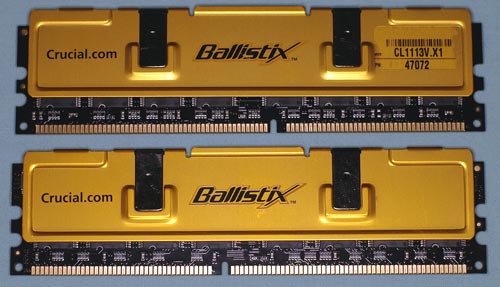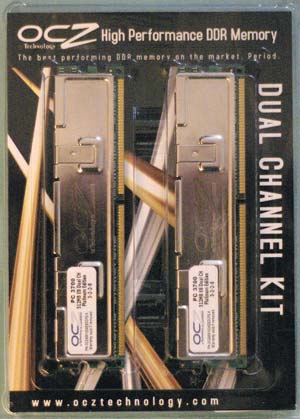High End Buyer's Guide - September 2004
by Wesley Fink on August 30, 2004 12:22 AM EST- Posted in
- Guides
DDR Memory
DDR Recommendation: 1GB Kit (2 X 512MB) Crucial Ballistix PC3200Price: $278 shipped
One of the advantages of the new AMD Socket 939 is that it uses regular unbuffered dual-channel memory. This means that almost any memory will fit your new Socket 939 system. Any of the new DDR400 2-2-2 memories will work fine on the Intel 875/865 platform, but we have found that some memory performs much better in Athlon 64 systems than others. The overall best Athlon 64 performance that we have found was with Crucial Ballistix PC3200, and our alternative OCZ 3700EB/3500EB. These two memories perform just as well on Intel DDR systems, but they stand alone in performing the same on the pickier Athlon 64 Socket 939 boards.

When Corsair 3200XL roared on the scene in May with a return of 2-2-2 timings to DDR400, we had no idea it was just the start of DDR400 2-2-2 from all the major memory makers. As you saw in our roundup of the new 2-2-2 memories, all of the new DDR400 2-2-2 performed well on the Intel test bed and all but one used Samsung memory chips. The exception was Crucial Ballistix, which used Micron memory chips and earned our Gold Editors Choice for best performance. Ballistix was also the only 2-2-2 memory tested in the roundup that performed just as well on Athlon 64 as it did on Intel, so it is a great match to the MSI K8N Neo2.
Crucial Ballistix also extends performance all the way to DDR500, with our test memory achieving the fastest timings that we have tested so far at DDR500. This will give you incredible headroom when you select this memory for your system.
Crucial is the well-respected retail division of memory-chip manufacturer Micron, and Crucial has earned regard from customers over years of providing quality memory products and excellent Customer Service. You will also find the Crucial Ballistix PC3200 an excellent value among DDR400 2-2-2 memory products.
DDR Alternative: 1GB Kit (2 X 512MB) OCZ PC3700 EB
Price: $325 shipped

OCZ 3700EB, and the similar 3500EB, are also based on Micron memory chips, which appear to be a better match to the Socket 939 than other memory chips that we have tested. The EB takes a little different approach to memory timings, and runs at 2.5-2-2 at DDR 400. This is still competitive with the best memory available, but by DDR433 to DDR450, the EB becomes one of the fastest memories we have tested at that speed. Performance extends well beyond DDR500 and the performance at DR500 is one of the best that we have tested. Many Athlon 64 boards are picky about memory, but every Athlon 64 board that we have tested so far seems quite content with either 3700EB or 3500EB memory.
End users are reporting very consistent results with overclocking OCZ 3700EB. For that reason, we consider the choice between Crucial Ballistix and OCZ EB a toss-up. Ballistix is better at DDR400, but EB is reliable in consistently reaching high overclocks on the MSI K8N Neo2.
OCZ has raised their Customer Service standards to among the best in the memory industry in the past year. We often get emails reporting very positive Customer Service and quick problem resolution when customers have contacted OCZ directly. OCZ combines that excellent Customer Service with a Lifetime Warranty.
Either of these DDR recommendations will work very well on the MSI K8N Neo2, Asus P4C800-E Deluxe, or DFI NFII Ultra Infinity. However, DDR2 memory is required for the Asus P5AD2 Premium.
Listed below is part of our RealTime pricing engine, which lists the lowest prices available on memory from many different reputable vendors:
If you cannot find the lowest prices on the products that we've recommended on this page, it's because we don't list some of them in our RealTime pricing engine. Until we do, we suggest that you do an independent search online at the various vendors' web sites. Just pick and choose where you want to buy your products by looking for a vendor located under the "Vendor" heading.










53 Comments
View All Comments
Wesley Fink - Wednesday, September 1, 2004 - link
Uff -The two FX53 I've tested both run fine at 2.6GHz (future FX55 spec) with stock cooling. While you will get more potential with better cooling, you are not locked out of using a higher multiplier just because you use stock cooling. The AMD Retail HSF does a decent job of cooling, though there are certainly better solutions available.
Uff - Wednesday, September 1, 2004 - link
My point with FX-53 and stock cooling was exactly that: the main bonus you get with FX-53 is that it's multiplier unlocked but to make any use of that you need proper cooling.Wesley Fink - Wednesday, September 1, 2004 - link
#40 - The DVD prices were pulled at slightly different times for the Recommended and Alternate systems. For consistency, both charts now show a $97 price for the Pioneer 108. Prices constantly change, so any published price will generally be off in a few days or weeks.Goi - Tuesday, August 31, 2004 - link
Why is it that the DVD burner in the recommended high-end system costs $97 yet the exact same one in the alternate high-end system costs $96?krawl3r - Tuesday, August 31, 2004 - link
every single time, these guides ignore 2 of the best PSUs on the market: the PC Power and Cooling 510Deluxe which is miles ahead of the antec. Also ignored is the Fortron 530s. In my experience, the Fortrons are at least on par with the Antecs of not equal.P.S. If you spend the money on an FX-53 you might as well get a server board and go with the 940pin version so you can plug in a SCSI RAID card and have an array of 73GB 15k drives....just my $0.02
neogodless - Tuesday, August 31, 2004 - link
There is no "be all, end all" guide to anything, particularly in a rapidly changing technology environment. This guide is merely a guide. A place to start from, and go from there. They recommend getting the keyboard and mouse that is right for you, whether it be $70 or $10. However, I think there may be some logic in requesting that there's more of a reasonable scale from budget, mainstream, and high-end. This high-end guide tries to balance having enough money to buy the fastest computer with trying to make it affordable to a relatively wide audience, but really, I think there may be a different way to go about it. I think you could save a lot of money for a minimally slower computer, and by doing that, saving money for your next high-end machine. If you get the absolutely fastest machine, then there really should be no limits on money, and it should really be a no budget dream machine. If you're on a budget, even if it's $5000, you might want to be a little tiny bit stingier, and make sure that six months or a year from now, you still have a good budget for getting a high end rig.The only typo I saw was "could care less" in the audio section. Should be "couldn't care less".
The guides are a lot of work, and I think they are somewhat reasonable starting points. I appreciate them, even though I don't really use them for my own purchasing decisions. They are interesting, and hopefully helpful to some people.
jbritt1234 - Tuesday, August 31, 2004 - link
How can you build a $3500 PC and then suggest a $10 mouse??? That's crazy! Lost a little respect for ya there.Wesley Fink - Tuesday, August 31, 2004 - link
Uff - The improvements from Dual-Channel and 1024k cache vs. 512k cache are cumulative. So while either improvement alone is only 2 to 4% improvement, together the added cache and dual channel make the FX53 5% to 8% faster than the SC 512k 3700+ you suggest. If you want the top performance then the FX53 is the fastest.The FX53 is also completely unlocked, up and down, unlike the 3700+, 3800+, 3500+, or 3400+, which makes it possible to run at 2.6GHz for example at DDR400. All Athlon 64 are unlocked down, but only the FX is completely unlocked.
Uff - Tuesday, August 31, 2004 - link
I'm just wondering why anyone in their right mind would buy an FX-53 and run it on stock cooling? Other than making more space in your room by taking out some of the spare piles of money, there is no real gain in it compared to say 3700+ (or even a 2.4GHz 3400+, since tests have shown little gain from the extra 512kb cache).Caligynemania - Tuesday, August 31, 2004 - link
I am surprised that you reccomend mere computer speakers for a high end system. A receiver/speaker system (albeit more expensive) would be more appropriate for a high end system. I realize that this is outside the scope of a computer buyer's guide, but I think anyone who truly appreciates music/sound/noise would be willing to spend the $500 for a set of speakers that will last a lifetime (speakers dont go obselete or break). Combined with a good receiver (additional $100) you can output amazing sound from the radio, tv, computer, dvd. For $500 you can get the amazing NHT SB3 speaker system or the Klipsch RB25's.